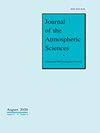副热带Rossby波在放大麦登-朱利安振荡发散环流中的作用
IF 2.8
3区 地球科学
Q2 METEOROLOGY & ATMOSPHERIC SCIENCES
引用次数: 0
摘要
众所周知,麦登-朱利安振荡(MJO)的复合结构在副热带对流层上部具有明显的罗斯比环流,其存在可以解释为在副热带西风急流存在的情况下对对流加热异常的强迫响应。这里感兴趣的问题是,这些强迫环流是否对热带地区的辐散模式和MJO的开尔文模式分量有任何后续影响?使用一个非线性球形浅水模型来研究不同背景射流剖面的引入如何影响模型对施加的类MJO稳态热强迫的稳态响应。结果表明,更强的喷流会导致热带地区更强的开尔文模式响应,达到临界喷流速度,并在强迫附近产生更强的发散异常。为了理解这种行为,进行了额外的计算,其中在热带外施加了局部涡度强迫,而在热带没有任何热强迫。只要喷流具有足够的振幅,该响应再次被视为包括明显的赤道开尔文波。对涡度预算的详细分析表明,纬向平均纬向风切变在放大赤道附近的开尔文模式发散风方面起着关键作用,非线性的影响可以忽略不计。这些结果有助于解释为什么在印度洋-太平洋喷气式飞机通常最强的北方冬季,MJO往往最强。本文章由计算机程序翻译,如有差异,请以英文原文为准。
The role of subtropical Rossby waves in amplifying the divergent circulation of the Madden Julian Oscillation
The composite structure of the Madden-Julian Oscillation (MJO) has long been known to feature pronounced Rossby gyres in the subtropical upper troposphere, whose existence can be interpreted as the forced response to convective heating anomalies in the presence of a subtropical westerly jet. The question of interest here is whether these forced gyre circulations have any subsequent effects on divergence patterns in the tropics and the Kelvin-mode component of the MJO? A nonlinear spherical shallow water model is used to investigate how the introduction of different background jet profiles affects the model’s steady-state response to an imposed MJO-like stationary thermal forcing. Results show that a stronger jet leads to a stronger Kelvin-mode response in the tropics up to a critical jet speed, along with stronger divergence anomalies in the vicinity of the forcing. To understand this behavior, additional calculations are performed in which a localized vorticity forcing is imposed in the extratropics, without any thermal forcing in the tropics. The response is once again seen to include pronounced equatorial Kelvin waves, provided the jet is of sufficient amplitude. A detailed analysis of the vorticity budget reveals that the zonal-mean zonal wind shear plays a key role in amplifying the Kelvin-mode divergent winds near the equator, with the effects of nonlinearities being of negligible importance. These results help to explain why the MJO tends to be strongest during boreal winter when the Indo-Pacific jet is typically at its strongest.
求助全文
通过发布文献求助,成功后即可免费获取论文全文。
去求助
来源期刊

Journal of the Atmospheric Sciences
地学-气象与大气科学
CiteScore
0.20
自引率
22.60%
发文量
196
审稿时长
3-6 weeks
期刊介绍:
The Journal of the Atmospheric Sciences (JAS) publishes basic research related to the physics, dynamics, and chemistry of the atmosphere of Earth and other planets, with emphasis on the quantitative and deductive aspects of the subject.
The links provide detailed information for readers, authors, reviewers, and those who wish to submit a manuscript for consideration.
 求助内容:
求助内容: 应助结果提醒方式:
应助结果提醒方式:


